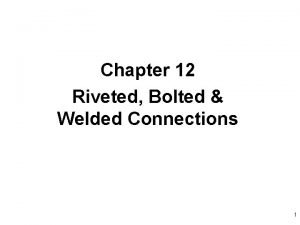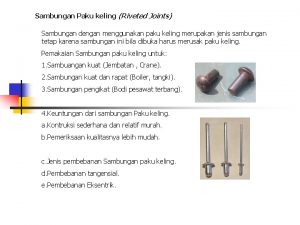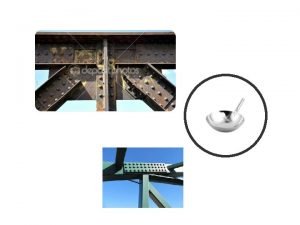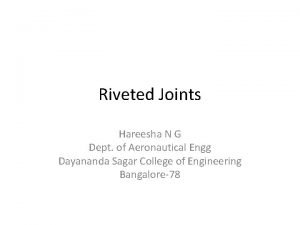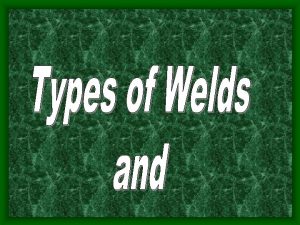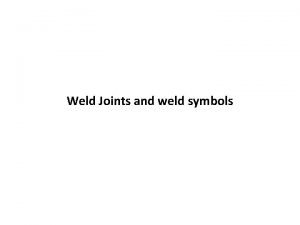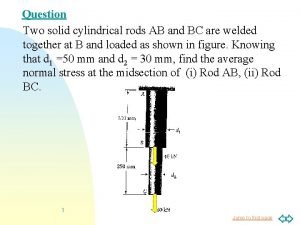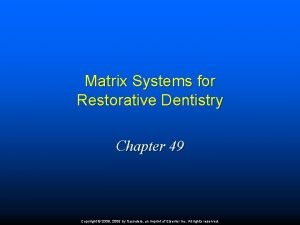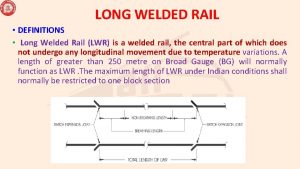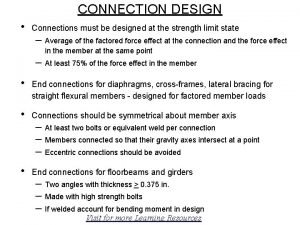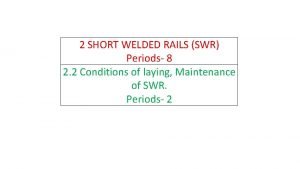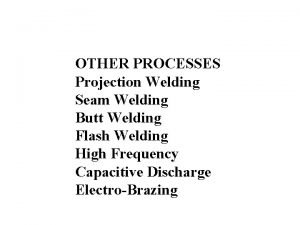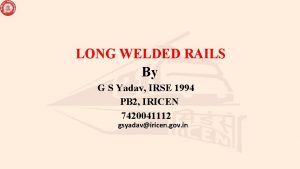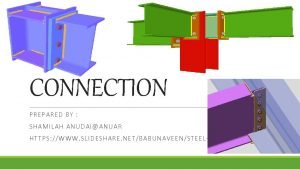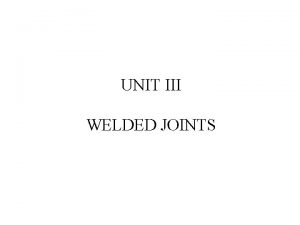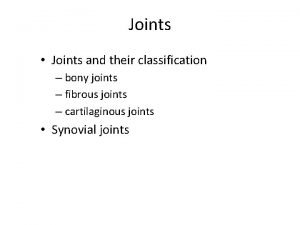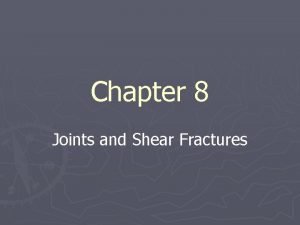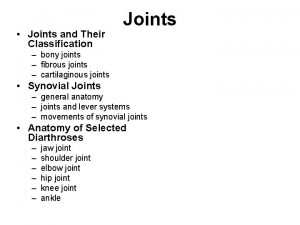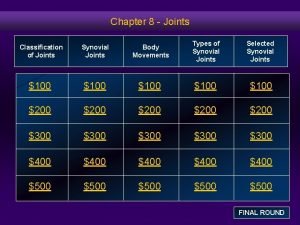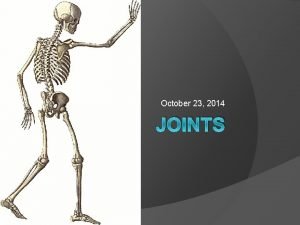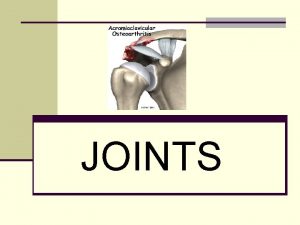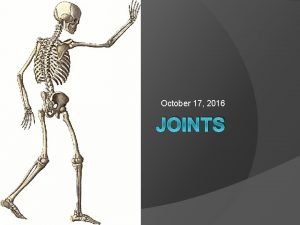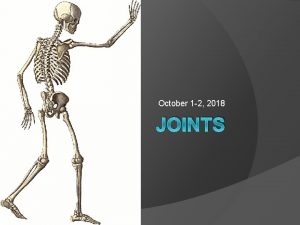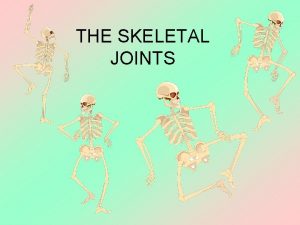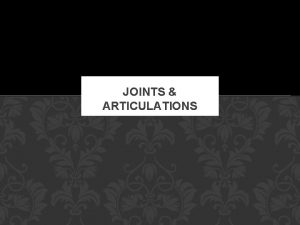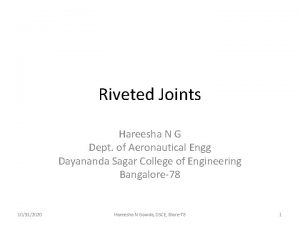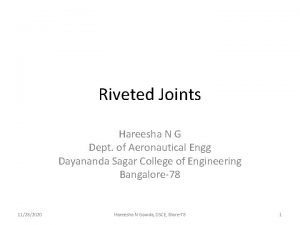RIVETED AND WELDED JOINTS RIVETED JOINTS A riveted



















- Slides: 19

RIVETED AND WELDED JOINTS

RIVETED JOINTS • A riveted joint is a permanent joint which uses rivets to fasten two materials. • Structure that has a hemispherical head on one side and a cyclindrical shaft on other. ` MATERIALS : • Aluminium alloys , Steel , METALS like titanium , nickel etc INITIAL FORM OF RIVETS

Important Terms Used in Riveted Joints • The following terms in connection with the riveted joints are important from the subject point of view : 1. Pitch. It is the distance from the centre of one rivet to the centre of the next rivet measured parallel to the seam as shown in Fig. It is usually denoted by p. 2. Diagonal pitch. It is the distance between the centres of the rivets in adjacent rows of zig-zag riveted joint. It is usually denoted by pd. 3. Margin or marginal pitch. It is the distance between the centre of rivet hole to the nearest edge of the plate. It is usually denoted by m. 5



RIVETED JOINTS TYPES OF RIVETED HEADS

RIVETED JOINTS TYPES OF RIVET JOINTS : LAP JOINTS : LAP JOINT In this type the ends carrying the drillings of the two members are positioned such that their surfaces slightly overlap. The riveting is done through the coincident holes. BUTT JOINTS : The two members or the elements are linked edge to edge in one straight line. The clamping is produced using an external cover plate which is then riveted as above through the parallel drilled holes. BUTT JOINT

Single Rivet Lap Joint RIVETED JOINTS SINGLE RIVET JOINT : One rivet is fixed along a single row typically in a lap joint , while in a butt joint the rows may appear from both the upper and the lower surfaces. Single Rivet butt Joint DOUBLE RIVET JOINT : When two rows of rivets are included over a lap joint or when two rows of rivets are utilized from both top and bottom in a butt joint are referred to as double butt joint. CHAIN RIVETED JOINT : Double Rivet chain type lap Joint In this type the accommodated rows of rivets may lie exactly opposite to each other over straight lines. ZIG ZAG RIVETED JOINT : Unlike the above type, here the rows may appear staggered and not complementing each other. Double Rivet zigzag type lap Joint



Failures of a Riveted Joint Tearing of the plate at an edge. Shearing of the rivets. Tearing of the plate across a row of rivets. Crushing of the plate or rivets.

Tearing of the plate at an edge. • A joint may fail due to tearing of the plate at an edge as shown in Fig. This can be avoided by keeping the margin, m = 1. 5 d, where d is the diameter of the rivet hole. m d

Tearing of the plate across a row of rivets. • Tearing of the plate across a row of rivets. Due to the tensile stresses in the main plates, the main plate or cover plates may tear off across a row of rivets as shown in Fig. 9. 14. In such cases, we consider only one pitch length of the plate, since every rivet is responsible for that much length of the plate only. The resistance offered by the plate against tearing is known as tearing resistance or tearing strength or tearing value of the plate.

Let p = Pitch of the rivets, d = Diameter of the rivet hole, t = Thickness of the plate, and σt = Permissible tensile stress for the plate material. Tearing area per pitch length, At = ( p – d ) t ∴ Tearing resistance or pull required to tear off the plate per pitch length, Pt = At. σ t = (p – d)t. σ t d d p

Shearing of the rivets. • The plates which are connected by the rivets exert tensile stress on the rivets, and if the rivets are unable to resist the stress, they are sheared off as shown in Fig.

Let d = Diameter of the rivet hole, τ = Safe permissible shear stress for the rivet material, and n = Number of rivets per pitch length. Shearing area, A s �� =4×d 2 . . . (In single shear) �� = 1. 875 × 4 × d 2 . . . (In double shear, IBR) ∴ Shearing resistance or pull required to shear off the rivet per pitch length, Ps �� 2 = n× 4 ×d ×τ. . . (In single shear) �� 4 = n × 1. 875 × × d 2 × τ . . . (In double shear, IBR)

Crushing of the plate or rivets. • Sometimes, the rivets do not actually shear off under the tensile stress, but are crushed as shown in. Due to this, the rivet hole becomes of an oval shape and hence the joint becomes loose. The failure of rivets in such a manner is also known as bearing failure. The area which resists this action is the projected area of the hole or rivet on diametric plane. P P

Let d = Diameter of the rivet hole, t = Thickness of the plate, σc = Safe permissible crushing stress for the rivet or plate material n = Number of rivets per pitch length under crushing. Crushing area per rivet (i. e. projected area per rivet), Ac = d. t Crushing resistance or pull required to crush the rivet per pitch length (for total n no. of rivets), Pc = n. d. t. σc

Efficiency of a Riveted Joint • The efficiency of a riveted joint is defined as the ratio of the strength of riveted joint to the strength of the un-riveted or solid plate. Pt , Ps and Pc η = Least of p×t×σ t Where, p = Pitch of the rivets, t = Thickness of the plate, σt = Permissible tensile stress of the plate material.
 Bolted and welded connections
Bolted and welded connections Kampuh berimpit
Kampuh berimpit Riveted joints
Riveted joints Double riveted zigzag lap joint
Double riveted zigzag lap joint Types of welding joint
Types of welding joint Types of welding symbols
Types of welding symbols Find the average normal stress at the midsection of rod ab
Find the average normal stress at the midsection of rod ab Welded wing formation
Welded wing formation Celluloid matrix band
Celluloid matrix band Spot welded matrix band
Spot welded matrix band Rail destressing formula
Rail destressing formula Welding connection design
Welding connection design Security fence trinidad
Security fence trinidad Compabloc plate heat exchanger
Compabloc plate heat exchanger Short welded rail
Short welded rail Welded wire mesh bending machine
Welded wire mesh bending machine China seamless line pipe
China seamless line pipe Seam welding definition
Seam welding definition Breathing length of lwr formula
Breathing length of lwr formula Bolted connection ppt
Bolted connection ppt
